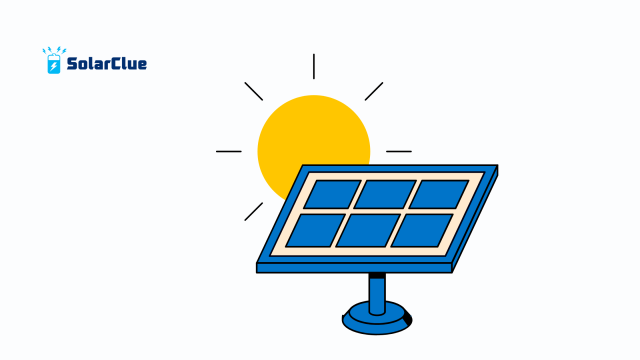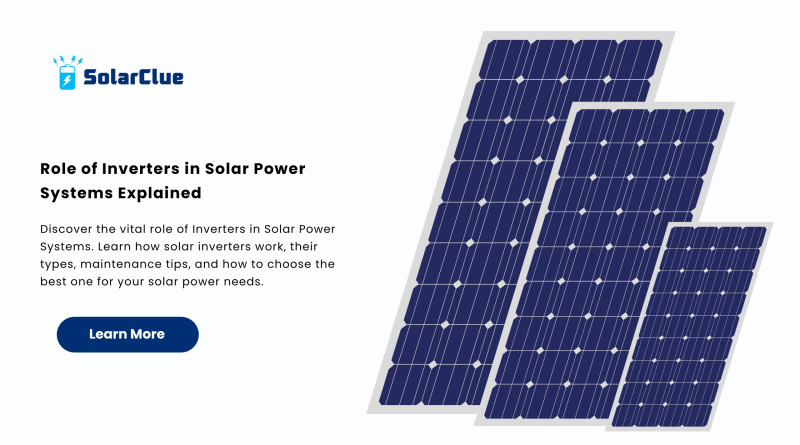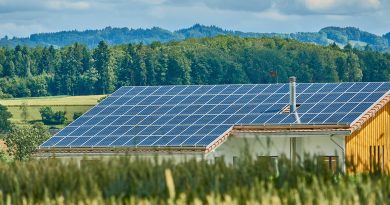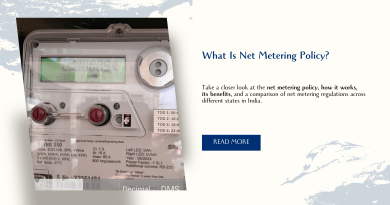Role of Inverters in Solar Power Systems Explained
Solar energy has become a revolutionary solution for powering homes and businesses sustainably. With increasing energy costs and environmental concerns, more people are turning to Solar Power Systems to meet their energy needs. However, generating electricity from the sun isn’t as simple as installing solar panels. The true magic happens inside a device called the inverter. Understanding the Role of Inverters in Solar Power Systems helps you maximize the benefits of solar energy, ensuring that the electricity produced is safe, efficient, and usable for all your appliances.
Table of Contents
- 1 What is a Solar Inverter?
- 2 Why Inverters are Essential in Solar Power Systems
- 3 How Solar Inverters Work
- 4 Different Types of Solar Inverters
- 5 Choosing the Best Solar Inverters
- 6 Solar Inverter Price Breakdown
- 7 Key Functions of Solar Inverters
- 8 Importance of Solar Inverter Efficiency
- 9 Solar Inverter Technology Trends
- 10 Solar Inverter Lifespan: What to Expect
- 11 Best Practices for Solar Inverter Maintenance
- 12 Solar Inverter Installation Tips
- 13 Conclusion
- 14 FAQs
What is a Solar Inverter?
A solar inverter is the unsung hero of your solar energy setup. Solar panels generate direct current (DC) electricity when exposed to sunlight. However, the electrical grid and your home appliances require alternating current (AC). This is where the inverter comes into play. When asking what does a solar inverter do, simply think of it as a translator—converting raw solar energy into a language your household devices can understand and use efficiently.
Why Inverters are Essential in Solar Power Systems
Without inverters in Solar Power Systems, the energy collected by solar panels would remain trapped in an unusable form. Beyond just converting DC to AC, inverters also manage power flow, optimize energy harvesting, provide system data, and ensure the safe operation of your system. They synchronize solar-generated electricity with the grid, ensuring your home seamlessly switches between solar power and grid electricity when needed. Whether you’re generating energy for immediate use or sending it back to the grid for credit, the inverter is the gatekeeper of your solar energy system.
How Solar Inverters Work
To truly understand how solar inverters work, imagine solar panels soaking up sunlight and creating a stream of DC electricity. This DC is then sent to the inverter, which uses electronic switches and transformers to flip the current direction at the precise frequency needed for AC power. Advanced inverters also track maximum power points to ensure that the system produces as much energy as possible. Without efficient conversion, even the best solar panels wouldn’t live up to their potential.
Different Types of Solar Inverters
String Inverters
String inverters connect multiple solar panels together in series (like Christmas lights). They are cost-effective and reliable, making them a popular choice for homes where all panels receive similar sunlight exposure throughout the day.
Microinverters
Microinverters attach to individual panels, allowing each panel to operate independently. They are a perfect choice when shading, roof angle, or orientation varies across different panels. Though more expensive upfront, microinverters often yield better system performance over time.
Power Optimizers
Power optimizers sit between solar panels and the string inverter, conditioning the DC electricity before it reaches the inverter. They maximize the output of each panel individually, combining some benefits of microinverters and string inverters at a lower cost.
Central Inverters
Primarily used in large commercial or utility-scale installations, central inverters handle huge capacities by combining the output from many strings of panels. They are cost-efficient for large-scale systems but not practical for residential use.
Hybrid Inverters
Hybrid inverters combine the functions of a solar inverter and a battery inverter into a single device. They allow you to store excess energy in batteries for use at night or during blackouts, offering greater energy independence.
Off-Grid Solar Inverter
An off-grid solar inverter is designed for systems not connected to the public electricity grid. They are crucial for cabins, remote homes, and locations where grid power is unreliable or unavailable. These inverters often work alongside battery banks to store solar energy.
Choosing the Best Solar Inverters

Selecting the best solar inverters involves evaluating efficiency, warranty, brand reputation, system compatibility, and real-world user feedback. Solar inverter reviews provide valuable insights into reliability and performance. You’ll want an inverter that suits your energy needs today and can adapt to potential system expansions in the future. Always balance cost and quality to ensure long-term satisfaction with your solar investment.
Solar Inverter Price Breakdown
The solar inverter price varies based on inverter type, capacity, technology, and brand. On average, residential solar inverters range from $500 to $2,000. Microinverters and hybrid inverters generally cost more due to their advanced technology. It’s important to consider not just the upfront price but also the efficiency, warranty, and expected lifespan when assessing overall value.
Key Functions of Solar Inverters
The primary solar inverter function is to convert DC electricity into AC, but their role doesn’t end there. They also:
-
Maximize energy harvest through tracking technology
-
Monitor system health and performance
-
Ensure compliance with grid requirements
-
Provide rapid shutdown in case of emergencies Modern inverters with smart technology can even detect faults at panel level, improving safety and efficiency.
Importance of Solar Inverter Efficiency
Solar inverter efficiency directly impacts how much of the electricity generated by your panels is usable. High-efficiency inverters, often boasting 95% to 99% efficiency ratings, ensure that you maximize your return on investment. Inverter inefficiency translates into lost savings, so investing in a top-performing model makes financial sense over the system’s lifespan.
Solar Inverter Technology Trends
Solar inverter technology has come a long way in recent years. Innovations include Wi-Fi connectivity for remote monitoring, AI-driven energy management systems, built-in EV chargers, and battery-ready hybrid models. These advancements provide homeowners with better control, improved energy production, and seamless integration into smart homes, making the transition to solar energy smoother and smarter than ever.
Solar Inverter Lifespan: What to Expect
The typical solar inverter lifespan ranges from 10 to 15 years, shorter than the 25-30 year lifespan of solar panels. Environmental factors like heat, humidity, and installation quality affect longevity. Choosing an inverter with a strong warranty and proven durability helps minimize maintenance costs and unexpected downtime over your system’s lifetime.
Best Practices for Solar Inverter Maintenance
Effective solar inverter maintenance is essential for ensuring long-term performance. Here are key tips:
-
Regularly inspect for dust, debris, or pest interference
-
Monitor inverter error codes and performance via connected apps
-
Ensure the inverter’s cooling system is not blocked
-
Schedule professional inspections annually Simple proactive steps can prevent major issues and extend your inverter’s life significantly.
Solar Inverter Installation Tips
Proper solar inverter installation can make or break your system’s performance. Always opt for certified installers with a good track record. Ensure the inverter is placed in a shaded, well-ventilated area to avoid overheating. Double-check that all electrical connections meet safety standards, and configure monitoring systems correctly so you can track performance easily.
Conclusion
In conclusion, understanding the Role of Inverters in Solar Power Systems is crucial for anyone considering solar energy. Inverters are much more than simple converters; they are the brains behind efficient energy use, system safety, and real-time monitoring. By choosing the right solar inverter, maintaining it properly, and staying updated with the latest solar inverter technology, you ensure your transition to solar power is smooth and rewarding. Ready to make the switch to clean energy? Visit solarclue.com today for top-quality solar products and expert advice, and dive deeper into the world of solar at blog.solarclue.com – your journey to energy independence starts now!
FAQs
1. What is the average solar inverter price?
The average solar inverter price for residential setups falls between $500 and $2,000, depending on technology and features.
2. How often should I perform solar inverter maintenance?
You should perform basic solar inverter maintenance at least once annually, with regular system monitoring monthly to catch issues early.
3. What are the signs that a solar inverter needs replacing?
Signs include frequent error codes, noticeably reduced energy production, overheating, or complete shutdown of the inverter.
4. Which solar inverter types are best for home use?
String inverters are ideal for homes with consistent sunlight, while microinverters or hybrid inverters are best for shaded or battery-backed systems in Solar Power Systems.
5. How do I choose the best solar inverters for my needs?
Assess your energy needs, check if battery storage is planned, read authentic solar inverter reviews, and consult a professional for personalized recommendations.



